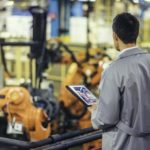 The rate of technology adoption inevitably varies considerably, whether between organizations, regions, or even countries. Research from the London School of Economics explores some of the factors that drive this variation
The rate of technology adoption inevitably varies considerably, whether between organizations, regions, or even countries. Research from the London School of Economics explores some of the factors that drive this variation
The researcher focused particularly on the relationship between the rate of cooperative institutions and the rate of roboticization in industry across 25 OECD countries. Cooperative institutions are defined as things like works councils and other sector organizations that aim to strike a balance between collective gain and distribution. For instance, they might help to facilitate bargaining between capital and labor.
Supporting adoption
While it may seem intuitive to assume that a higher prevalence for such organizations might inhibit the spread of automation across industry, the study actually found that it led to more industrial automation while also ensuring more equitable outcomes for workers.
The author notes that despite many European countries being similarly advanced economically, the rate of robot adoption varies considerably, from high-adoption countries like Germany to low-adoption countries like the U.K.
Traditionally the role of domestic institutions has been used to explain this difference, with a particular emphasis on the role these institutions play in industrial relations. This account suggests that the interests of capital and labor are opposed, such that more institutionalized labor markets inevitably slow the adoption of automation.
Similarly, a common argument is that when labor is highly organized, it also encourages employers to invest in automation as a way of circumventing organized labor.
Mutual benefits
When the author examined the situation more closely, however, they discovered that the interests of employers and employees are not opposed at all, but instead rather complementary. For instance, they highlight how organizations profit from having employees buy into their strategy.
There are also gains to be had by virtue of employees showing a willingness to invest time and effort in retraining so that their skills better complement the new technology.
This is also a situation that benefits employees, not least as other research has shown that firms deploying automation tend to employ more workers than those that don’t as these firms tend to grow more, which prompts them to increase headcount.
What’s more, productivity growth as a result of automation has made households wealthier while also making work both less strenuous and safer, albeit with some short-term disruption of jobs commonplace.
Cooperation helps smooth the transition
It is during this transition that the LSE research shows that cooperative institutions come to the fore. They can help to ensure that the costs and benefits of automation are spread more equitably between employers and employees.
For instance, firms with work councils have often provided employees with guarantees that no redundancies will result from the investment in automation, which in turn makes employees more interested in the benefits that accrue from automation in terms of productivity-linked wage rises. Indeed, the study suggests that workers are even more inclined to share potential new technologies with management in such environments.
This coincides with a greater willingness to train and ensure that they’re well adapted to the new technology and can work effectively alongside it, which in turn ensures that the firm maximizes the return on investment in the technology.
Macro benefits
These advantages also emerged on a more macro level, where policies can be worked on collectively that help enables automation to thrive. This strongly suggests that automation can derive benefits for both employer and employee alike when more cooperative structures are in place.
This is a marked contrast to more liberal economies, such as the U.K. and U.S., where greater automation is more strongly associated with a declining share of the economic pie for workers.
Much of the fears associated with automation and the adoption of robotics and AI revolve around the disruption they will invoke on jobs and livelihoods. The research challenges the notion that such conflict is inevitable and instead reminds us that it’s possible for automation to emerge in ways that benefit workers as well as owners.
Much of the debate around automation, and indeed the future of work, is driven by the United States, but the research is a timely reminder that not all countries will make this transition in the same way. For such a harmonious transition to emerge, the author believes that it’s vital that automation is something that is done with all stakeholders at the table.